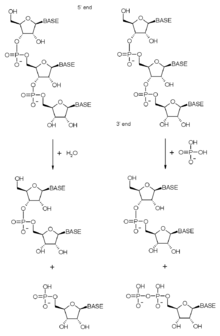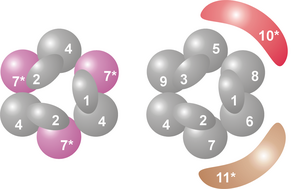Exosome complex

The exosome complex (or PM/Scl complex, often just called the exosome) is a multi-
carries out similar functions.The core of the exosome contains a six-membered ring structure to which other proteins are attached. In eukaryotic cells, the exosome complex is present in the
Several proteins in the exosome are the target of
Discovery
The exosome was first discovered as an
Structure
Core proteins

The core of the complex has a ring structure consisting of six proteins that all belong to the same class of RNases, the RNase PH-like proteins.[7] In archaea there are two different PH-like proteins (called Rrp41 and Rrp42), each present three times in an alternating order. Eukaryotic exosome complexes have six different proteins that form the ring structure.[8][9] Of these six eukaryotic proteins, three resemble the archaeal Rrp41 protein and the other three proteins are more similar to the archaeal Rrp42 protein.[10]

Located on top of this ring are three proteins that have an S1 RNA binding domain (RBD). Two proteins in addition have a K-homology (KH) domain.[7] In eukaryotes, three different "S1" proteins are bound to the ring, whereas in archaea either one or two different "S1" proteins can be part of the exosome (although there are always three S1 subunits attached to the complex).[11]
This ring structure is very similar to that of the proteins
In the case of PNPase, which is a phosphorolytic RNA-degrading protein found inAssociated proteins
Besides these nine core exosome proteins, two other proteins often associate with the complex in eukaryotic organisms. One of these is Rrp44, a hydrolytic RNase, which belongs to the
The second common associated protein is called Rrp6 (in yeast) or PM/Scl-100 (in human). Like Rrp44, this protein is a hydrolytic exoribonuclease, but in this case of the RNase D protein family.[21] The protein PM/Scl-100 is most commonly part of exosome complexes in the nucleus of cells, but can form part of the cytoplasmic exosome complex as well.[22]
Regulatory proteins
Apart from these two tightly bound protein subunits, many proteins interact with the exosome complex in both the cytoplasm and nucleus of cells. These loosely associated proteins may regulate the activity and specificity of the exosome complex. In the cytoplasm, the exosome interacts with AU-rich element (ARE) binding proteins (e.g. KRSP and TTP), which can promote or prevent degradation of mRNAs. The nuclear exosome associates with RNA binding proteins (e.g. MPP6/Mpp6 and C1D/Rrp47 in humans/yeast) that are required for processing certain substrates.[7]
In addition to single proteins, other protein complexes interact with the exosome. One of those is the cytoplasmic Ski complex, which includes an RNA helicase (Ski2) and is involved in mRNA degradation.[23] In the nucleus, the processing of rRNA and snoRNA by the exosome is mediated by the TRAMP complex, which contains both RNA helicase (Mtr4) and polyadenylation (Trf4) activity.[24]
Function
Enzymatic function

As stated above, the exosome complex contains many proteins with ribonuclease domains. The exact nature of these ribonuclease domains has changed across evolution from bacterial to archaeal to eukaryotic complexes as various activities have been gained and lost. The exosome is primarily a 3'-5'
In archaea, the Rrp41 subunit of the complex is a phosphorolytic exoribonuclease. Three copies of this protein are present in the ring and are responsible for the activity of the complex.[9] In eukaryotes, none of the RNase PH subunits have retained this catalytic activity, meaning the core ring structure of the human exosome has no enzymatically active protein.[25] Despite this loss of catalytic activity, the structure of the core exosome is highly conserved from archaea to humans, suggesting that the complex performs a vital cellular function. In eukaryotes, the absence of the phosphorolytic activity is compensated by the presence of the hydrolytic enzymes, which are responsible for the ribonuclease activity of the exosome in such organisms.[26][27][28]
As stated above, the hydrolytic proteins Rrp6 and Rrp44 are associated with the exosome in yeast and in humans, besides Rrp6, two different proteins, Dis3 and Dis3L1 can be associated at the position of the yeast Rrp44 protein.[19][20] Although originally the S1 domain proteins were thought to have 3'-5' hydrolytic exoribonuclease activity as well, the existence of this activity has recently been questioned and these proteins might have just a role in binding substrates prior to their degradation by the complex.[26]

Substrates
The exosome is involved in the degradation and
Although most cells have other enzymes that can degrade RNA, either from the

The exosome is a key complex in cellular RNA quality control. Unlike prokaryotes, eukaryotes possess highly active RNA surveillance systems that recognise unprocessed and mis-processed RNA-protein complexes (such as
In addition to RNA processing, turnover and surveillance activities, the exosome is important for the degradation of so-called cryptic unstable transcripts (CUTs) that are produced from thousands of loci within the yeast genome.[37][38] The importance of these unstable RNAs and their degradation are still unclear, but similar RNA species have also been detected in human cells.[39]
Disease
Autoimmunity
The exosome complex is the target of
In these diseases, antibodies are mainly directed against two of the proteins of the complex, called PM/Scl-100 (the RNase D like protein) and PM/Scl-75 (one of the RNase PH like proteins from the ring) and antibodies recognizing these proteins are found in approximately 30% of patients with the PM/Scl overlap syndrome.[43] Although these two proteins are the main target of the autoantibodies, other exosome subunits and associated proteins (like C1D) can be targeted in these patients.[44][45] At the current time, the most sensitive way to detect these antibodies is by using a peptide, derived from the PM/Scl-100 protein, as the antigen in an ELISA, instead of complete proteins. By this method, autoantibodies are found in up to 55% of patients with the PM/Scl overlap syndrome, but they can also be detected in patients with either scleroderma, polymyositis, or dermatomyositis alone.[46]
As the autobodies are found mainly in patients that have characteristics of several different autoimmune diseases, the
Cancer treatment
The exosome has been shown to be inhibited by the
Neurological disorders
Mutations in
List of subunits
| Legend | General name | Domains | Human | Yeast (S. cerevisiae) | Archaea | MW (kD)
|
Human gene | Yeast gene |
|---|---|---|---|---|---|---|---|---|
| 1 | Csl4 | S1 RBD | hCsl4 | Csl4p/Ski4p | Csl4 | 21–32 | EXOSC1 | YNL232W |
| 2 | Rrp4 | S1/KH RBD | hRrp4 | Rrp4p | Rrp4 | 28–39 | EXOSC2 | YHR069C |
| 3 | Rrp40 | S1/KH RBD | hRrp40 | Rrp40p | (Rrp4)A | 27–32 | EXOSC3 | YOL142W |
| 4 | Rrp41 | RNase PH | hRrp41 | Rrp41p/Ski6p | Rrp41C | 26–28 | EXOSC4 | YGR195W |
| 5 | Rrp46 | RNase PH | hRrp46 | Rrp46p | (Rrp41)A,C | 25–28 | EXOSC5 | YGR095C |
| 6 | Mtr3 | RNase PH | hMtr3 | Mtr3p | (Rrp41)A,C | 24–37 | EXOSC6 | YGR158C |
| 7 | Rrp42 | RNase PH | hRrp42 | Rrp42p | Rrp42 | 29–32 | EXOSC7 | YDL111C |
| 8 | Rrp43 | RNase PH | OIP2 | Rrp43p | (Rrp42)A | 30–44 | EXOSC8 | YCR035C |
| 9 | Rrp45 | RNase PH | PM/Scl-75 | Rrp45p | (Rrp42)A | 34–49 | EXOSC9 | YDR280W |
| 10 | Rrp6 | RNase D | PM/Scl-100C | Rrp6pC | n/a | 84–100 | EXOSC10 | YOR001W |
| 11 | Rrp44 | RNase R | Dis3B,C | Rrp44p/Dis3pC | n/a | 105–113 | DIS3
DIS3L1
|
YOL021C |
- A In archaea several exosome proteins are present in multiple copies, to form the full core of the exosome complex.
- B In humans, two different proteins can be associated in this position. In the cytoplasm of cells, Dis3L1 is associated with the exosome, whereas in the nucleus, Dis3 can bind to the core complex.
- C Contributes to the ribonucleolytic activity of the complex.
See also
- The proteasome, the main protein degrading machinery of cells
- The spliceosome, a complex involved in RNA splicing, that also contains an RNA binding ring structure
References
- ^ S2CID 16035676.
- PMID 10465791.
- PMID 11110791.
- S2CID 14817671.
- PMID 11157787.
- PMID 12947419.
- ^ PMID 16939780.
- S2CID 2003922.
- ^ PMID 17174886.
- PMID 12419256.
- S2CID 27114625.
- PMID 12746447.
- PMID 14767080.
- PMID 11080643.
- PMID 17514363.
- S2CID 1808371.
- PMID 19129231.
- PMID 17643380.
- ^ PMID 20531389.
- ^ PMID 20531386.
- PMID 9241229.
- PMID 15346807.
- PMID 16043509.
- S2CID 14898055.
- .
- ^ S2CID 24691764.
- S2CID 62785677.
- PMID 16285928.
- PMID 14527413.
- PMID 17660569.
- PMID 17470429.
- ^ PMID 10508172.
- PMID 16396833.
- PMID 17545563.
- PMID 12035760.
- S2CID 22499032.
- S2CID 1390706.
- S2CID 4329373.
- PMID 19056938.
- PMID 12410095.
- PMID 2199097.
- PMID 3918546.
- PMID 14872500.
- PMID 11879549.
- PMID 17599775.
- PMID 15899056.
- PMID 17643929.
- S2CID 39237322.
- S2CID 11922219.
- PMID 22544365.
Further reading
- Schilders, G; Pruijn, GJ (2008). "Chapter 11 Biochemical Studies of the Mammalian Exosome with Intact Cells". RNA Turnover in Eukaryotes: Nucleases, Pathways and Analysis of mRNA Decay. Methods in Enzymology. Vol. 448. pp. 211–226. PMID 19111178.
- Houseley, J; Tollervey, D (2008). "The nuclear RNA surveillance machinery: the link between ncRNAs and genome structure in budding yeast?". Biochim Biophys Acta. 1779 (4): 239–246. PMID 18211833.
- Vanacova, S; Stefl, R (2007). "The exosome and RNA quality control in the nucleus". EMBO Reports. 8 (7): 651–657. PMID 17603538.
- Büttner, K; Wenig, K; Hopfner, KP (2006). "The exosome: a macromolecular cage for controlled RNA degradation". Molecular Microbiology. 61 (6): 1372–1379. S2CID 6872855.
- Lorentzen, E; Conti, E (2006). "The Exosome and the Proteasome: Nano-Compartments for Degradation". Cell. 125 (4): 651–654. PMID 16713559.
- Pruijn, GJ (2005). "Doughnuts dealing with RNA". Nature Structural & Molecular Biology. 12 (7): 562–564. S2CID 43218090.
External links
- Structure of the human exosome at the RCSB Protein Data Bank
- Structure of an archaeal exosome at the RCSB Protein Data Bank
- Structure of an archaeal exosome bound to RNA at the RCSB Protein Data Bank
- Structure of the yeast exosome protein Rrp6 at the RCSB Protein Data Bank
- 3D macromolecular structures of exosomes at the EM Data Bank(EMDB)
